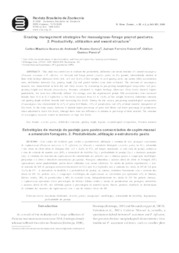Grazing management strategies for massaigrass-forage peanut pastures. 2. Productivity, utilization and sward structure.
Grazing management strategies for massaigrass-forage peanut pastures. 2. Productivity, utilization and sward structure.
Author(s): ANDRADE, C. M. S. de; GARCIA, R.; VALENTIM, J. F.; PEREIRA, O. G.
Summary: This study was carried out to evaluate the productivity, utilization and sward structure of a mixed massaigrass (Panicum maximum x P. infestum, cv. Massai) and forage peanut (Arachis pintoi Ac 01) pasture, intermittently stocked at three daily herbage allowance levels (9.0, 14.5 and 18.4% of live weight). In each grazing cycle, dry matter (DM) accumulation rates, defoliation intensity (%), grazing depth (%) and grazed horizon (cm) were evaluated. The structure of massaigrass tussocks was characterized in both dry and rainy seasons by measuring its pre-grazing morphological composition and postgrazing height and density (tussocks/m). Pastures submitted to higher herbage allowance (HA) levels showed higher productivity, but were less efficiently utilized. On average, over the experimental period, DM accumulation rates increased linearly from 56.8 to 81.3 kg/ha/day as HA levels increased from 9.0 to 18.4% of live weight. However, defoliation intensity and grazing depth declined linearly with increasing HA levels. During the dry season, pre-grazing morphological composition of massaigrass was characterized by 41% of green leaf blades, 10% of pseudostems and 49% of dead material, irrespective of HA levels. In the rainy season, however, it showed higher percentage of green leaf blades and lower percentage of pseudostems when submitted to lower HA levels, although there were not differences in relation to percentage of dead material. The structure of massaigrass tussocks tended to deteriorate at high HA levels.
Publication year: 2006
Types of publication: Journal article
Unit: Embrapa Acre
Keywords: Acumulación de materia seca, Agronomic traits, Amendoim forrageiro, Arachis pintoi, Capim massai, Características Agronômicas, Defoliación, Defoliation, Desfolha, Dry matter accumulation, Forage legumes, Forage peanut, Grazing depht, Hybrids, Híbrido, Híbridos, Leguminosa forrageira, Leguminosas forrajeras, Matéria seca, Mixed grazing, Mixed massaigrass, Morfologia vegetal, Morfología de las plantas, Panicum maximum x P infestum cv Massai, Pastagem consorciada, Pastejo, Pastoreo mixto, Plant morphology, Profundidad de pastoreo, Profundidade do pastejo
Observation
Some of Embrapa's publications are published as ePub files. To read them, use or download one of the following free software options to your computer or mobile device. Android: Google Play Books; IOS: iBooks; Windows and Linux: Calibre.
Access other publications
Access the Agricultural Research Database (BDPA) to consult Embrapa's full library collection and records.
Visit Embrapa Bookstore to purchase books and other publications sold by Embrapa.

